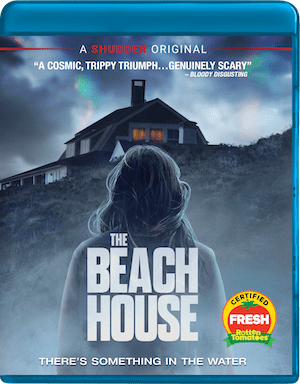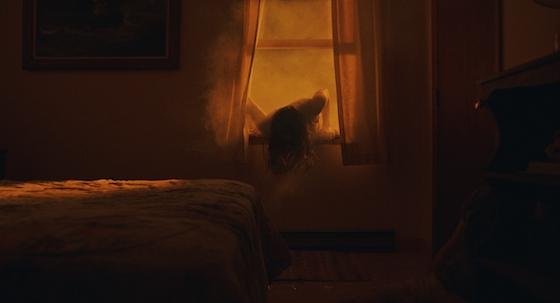
Out Tuesday, Dec. 15 on VOD, Digital HD, DVD and Blu-ray from RLJE Films.
Director/writer Jeffrey A. Brown‘s feature debut, The Beach House (on VOD, Digital HD, DVD and Blu-ray from RLJE Films Tuesday, December 15), is a slow-burn turn from relationship drama to creeping cosmic horror. After appearances as part of the Brooklyn Horror Film Festival, Chattanooga Film Festival, Strasbourg European Fantastic Film Festival, and Sitges International Fantastic Film Festival, Brown’s film has generated a lot of acclaim, and for good reason. The Beach House is the Lovecraftian terror for which I’d long hoped, but had yet to see fully realized onscreen. It’s absolutely one of my favorite horror films of the year, and so, I was thrilled to get a chance to hop of the phone with director/writer Brown to discuss how this excellent piece of small-budget terror came to be.
One of the things that’s been noted a lot about The Beach House is that it does a lot with a little. It’s a one setting film, so what was the process of crafting this tale and making it seem as big as the ideas are with the budget and locale as small as they are?
I’ve been doing locations on movies for 20 years. I come from very small films – it’s where I cut my teeth – and I don’t believe that budget equates quality. I root for the underdogs. I really like lower-budget movies like Coherence and Upstream Color – these very intimate small films that were low budget and had these big ideas. That was really part of the gestation of it: to try to accomplish that. Sometimes, as much as I like them, I am disappointed in a lot of indie dramas where they have these four characters in one location and it’s like, “They laugh, they cry, we learn a little something about life, and call it a day” and and I wanted to kind of take that concept and really push it as far as you can.
We can still have the four characters, one location but let’s think about the origins of life on the planet and hopefully planting those seeds in the audience when they’re watching the movie. It’s not just characters being chased by creatures – I love that, too – but it’s like, “Where is this coming from?” and to try to give it not a sense of reality, but a grounding in something to pique the the audience’s interest. I hope that somebody would see it and then be interested in what the characters are interested in and and what they’re talking about, because I’m interested in that stuff. I find it fascinating.
I still read lots of pop science books because I’m not in college anymore, so I’m not going to read text but it’s just my natural curiosity and I’d hope that the curiosity of the characters would instill a sense of curiosity in the audience, so it all is intertwined.

Were you going for a Lovecraftian vibe – also, I feel a little Junji Ito-type stuff in there, as well – or is that just what came out as as the film was being put together visually?
Lovecraft was definitely in there. I mean, he’s come up kind of way more than I ever thought he would. I think I’m going to owe that to Color Out Of Space coming out around the same time. I think Color Out Of Space actually shot after we shot The Beach House. That, I think is at least the third version? There was that one movie with Boris Karloff that’s awful from the ’60s [Die, Monster, Die!] and then The Curse – which is actually I think pretty underrated – from the ’80s is also Color Out Of Space.
I think we were we were cutting the movie and the editor’s like, “Hey, I hear they’re making Color Out Of Space.” Like, “Oh, great. Who’s making it?” and they’re like, “Spectrevision,” and they did Mandy and I love Mandy, so it was like, “Fantastic! Who’s directing it?” “Oh, Richard Stanley.” So, it was like, “Oh my, god. Really? Like, this year?”
I think it’s brought some associations but I definitely think there’s something in the water – pun intended – in terms of climate change and global pandemics and other types of afflictions that are that are affecting people. I think that movies, and especiallly horror films are the id of whoever’s making them, so I think that that was coming through.
Lovecraft, if you look up his definition of what a “weird tale” is, The Beach House is pretty much exactly it. It was from reading a lot of his fiction and then others like William Hope Hodgson and Arthur Machen and – who wrote The Willows? Algernon Blackwood. It was taking those ideas and then applying it to a contemporary setting which is what I hadn’t seen in a movie before: what could a contemporary cosmic horror film look like or what could it be? Then, on top of it, how can we do that without a big budget?
Sometimes I feel that directors are correcting movies. I love John Carpenter but I’m not crazy about The Fog. I love the opening sequence of it. It’s, to me, the best thing about the movie and then it doesn’t quite work for me, so I was like, “Well, what would what would I want The Fog to be?” Similarly, The Mist is another one that comes up a lot and we probably had 1/40th or even less than the budget of The Mist, so how can we convey some similar ideas that Stephen King was writing about in that and The Tommyknockers into four characters and maybe a half million dollar budget or whatever it wound up being.
It was always gonna be a small movie and I wanted to make a movie that you couldn’t make with a big budget so that it wouldn’t be a square peg in a round hole where the whole time we’d just be like, “Man, it’d be great if we had 20 million dollars!” It’s like, “We’re not gonna have 20 million dollars. We have this small amount of money. Let’s make the best movie we can for that amount of money.”
It seems that, because so much of the movie hinges on the character of Emily, that casting the role must have been a very uh important thing for you. How did you come to cast Liana Liberato in the part?
I think with a lot of of things there’s a lot of luck involved. Timing is another thing. We shot for essentially three weeks, three and a half weeks and so, it kind of went down to the wire. With Liana, I met with several actresses and Liana really came after it. She’s a great actress. I really learned a lot about acting from her – and from all the actors. They all come from very different places and experience levels. Liana has been acting for over a decade. She’s been acting since she was a kid. Jake Weber is a very experienced actor. Maryann [Nagel] comes from a totally different background than either of them and. Noah [Le Gros] is, I think, older than Liana but hasn’t been acting as long, so they all come from very different things.
It was very hard to cast Emily because I had some particular things that I didn’t want the character to be. She had to be able to really express her intelligence and and not be like some movies, where you watch and this one character is a rocket scientist and you’re like, “Yeah, no way.” I think that Liana does that very very well: she just sells every line. You know she knows what she’s talking about in the course of the movie. That was the most important thing.
She’s totally photogenic and she is a great, almost athletic actress. Physically and mentally, she just embodies the frame and the scene. It’s like she’s not acting – she’s being, which is what the best actors do.





Comments on this entry are closed.